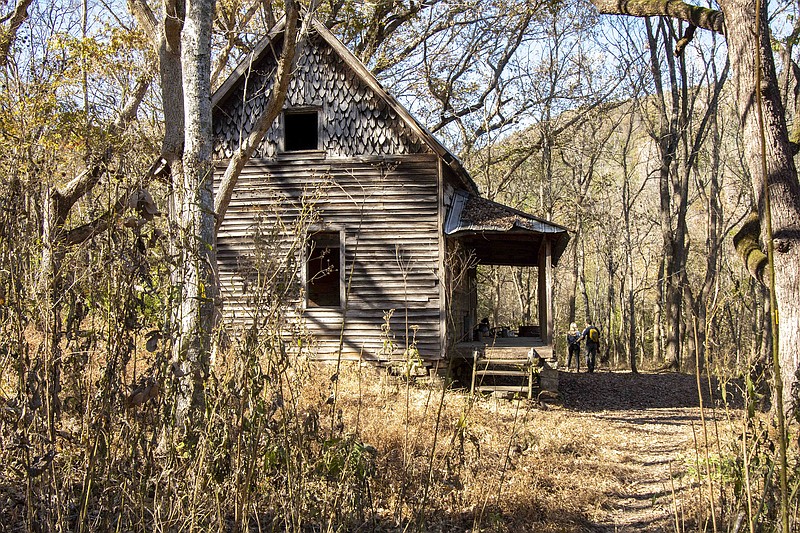This story is part of an ongoing series on historically significant places in Arkansas. See more at arkansasonline.com/endangered.
Before the Buffalo National River became a national river in 1972, families lived and farmed in the mountains and hills it traverses. Some of the old cabins, homesteads and barns still dot the rugged Ozarks landscape, giving visitors something to explore.
One of those cabins in Newton County, built by Frank and Eva Barnes Henderson around 1905, has been nominated to the National Register of Historic Places.
"Granny" Henderson, as she was known locally, lived near the Buffalo and was one of the last residents to leave when the National Park Service bought property in the 1970s. Her cabin, near Sneeds Creek, is a two-story, four-room house with a wide front porch. Fish-scale shingles add a design element and a bit of charm to the upper story on each end of the home.
Henderson lived alone for more than 20 years after the death of her husband. She kept up their farm, including cattle, hogs and chickens. Her home had neither electricity nor indoor plumbing.
Brock Hyland helped get the nomination process started. When he was a student at the University of Arkansas, Fayetteville, the Texas native spent a lot of time on the river and hiking the mountains. "It's just something you do when you go to school there," he says.
He doesn't recall how he learned about Granny Henderson's Cabin but thinks he might have read about it in one of Tim Ernst's hiking books. On a hike five or six years ago, he saw that vandals had spray-painted the cabin.
"Why would anyone want to damage this historically, culturally relevant structure? Why carry spray paint all the way out here to do that? It kind of got me thinking," he says. "Why isn't anyone looking after this building?"
In 2019, Hyland had a chance to bring attention to the cabin when, after graduating from college, he served as an intern in Gov. Asa Hutchinson's office. "I worked in the policy shop, and they would encourage you to pursue policy interests. And this wasn't on their radar," he says about the cabin. "I basically just typed up a memo about it, how it's important to preserve it, and gave it to the governor. He liked it."
The governor gave Hyland permission to pursue the cause. So, he presented the information to Arkansas Department of Parks, Heritage and Tourism Secretary Stacy Hurst, who agreed the cabin was an important part of state history. The nomination process was set in motion.
The next step was for Ralph Wilcox, the National Register/Survey coordinator for the Arkansas Historic Preservation Program, to research the cabin and do paperwork for the nomination. This was presented Aug. 5 to the Arkansas Historic Preservation State Review Board, a committee that works with the historic preservation program to approve nominations to the National Register of Historic Places. The decision was unanimous to proceed with the nomination. Placement on the National Historic Register will be reviewed this fall.
The site, officially known as the Frank and Eva Barnes "Granny" Henderson Farm, was nominated under Criterion A — a site that has associations with historic events or trends, Wilcox explained. He says the homestead is associated with a kind of agriculture and agricultural lifestyle.
The isolated farm included a barn, root cellar and other outbuildings.
The farm was also nominated under Criterion B, Wilcox says — association with a significant person.
"Granny Henderson was featured in National Geographic along with other publications because of the fact that she had retained a lifestyle and continued to live as kind of a pioneer. Her house never had indoor plumbing, never had running water, never had electricity, never had central heat and air. She lived there until the 1970s.
"It really was a kind of an unusual lifestyle at that period."
On Sept. 23, 1978, the Springfield Leader and Press reported that the 86-year-old Henderson planned to move in with her daughter "up the hill."
Henderson would have been allowed to stay on the land under a lease agreement, the article stated, but the lease said each person could only have domesticated animals: "That would mean Granny would be living without her livestock, the cows and chickens and pigs she tended daily for decades. Electricity and telephone and plumbing she can do without, but to stay in the wilderness without the company of her four-footed friends was too bleak a prospect even for someone as independent and gritty as Granny."
The cabin can be reached via several trails, including the Centerpoint and Sneeds Creek trails. A visit to the cabin is not an easy feat for the nonhiker. It's a rugged, rocky descent about four miles down from the Compton Trailhead, but it is a place that Hyland says "represents everything about the Ozarks, the people and their rugged individualism."
"I think it's important to put yourself in this isolated environment to really understand how she lived."
